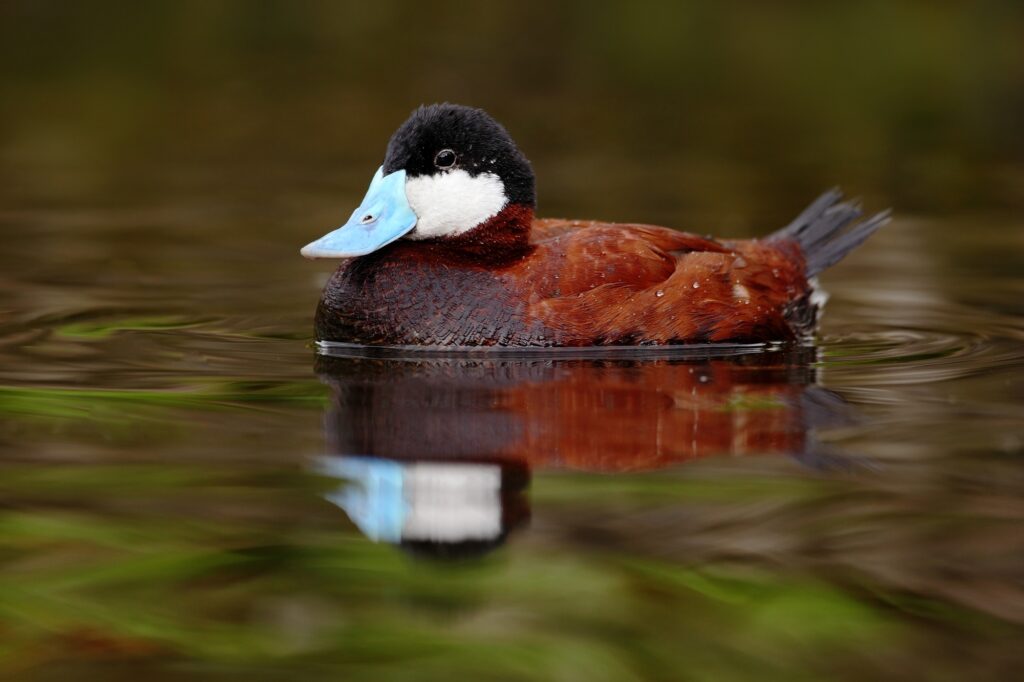Each spring and fall, lakes, wetlands, and rivers in West Virginia fill up with ducks on their annual migrations to and from southern, coastal areas.
The Mountain State provides important stopover habitat for many birds, including shovelers, wigeons, teals, and scaup, among many others.
There are also plenty of ducks that spend the whole year or winter visitors that stay for several months, with the Ohio River among the state’s top waterfowl destinations.
All measurements are courtesy of the Cornell Lab of Ornithology’s All About Birds, where you can find more information about each of these birds, including range maps, interesting facts, and more.
Dabbling Ducks
Mallard
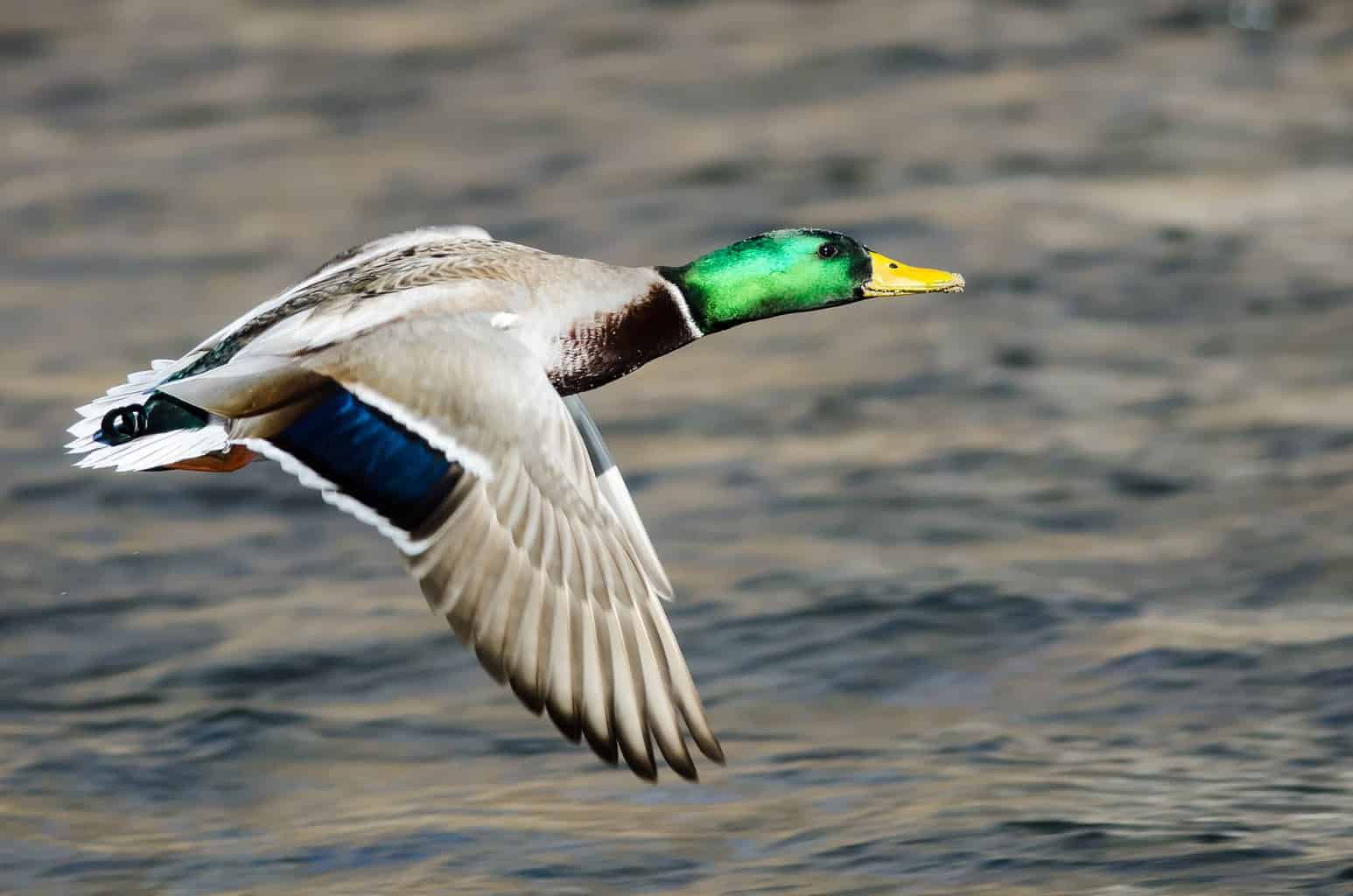
- Anas platyrhynchos
- Length: 19.7-25.6 inches
- Weight: 35.3-45.9 ounces
- Wingspan: 32.3-37.4 inches
Our list starts with America’s most common duck, the mallard. From rivers and lakes to parks and ditches, there’s seemingly nowhere a mallard won’t take up residence.
Often seen in pairs, mallard males’ green heads are instantly recognizable against their otherwise gray and brown bodies. In flight, they have a blue wing patch flanked by white.
Females’ wing patches are also blue, but they don’t have the signature green head that so many people associate with mallards. They’re all brown, with a bill that is mostly orange or gray.
Northern Shoveler

- Spatula clypeata
- Length: 17.3-20.1 inches
- Weight: 14.1-28.9 ounces
- Wingspan: 27.2-33.1 inches
Speaking of green-headed males, next up is the northern shoveler, whose males have heads of a similar hue to the mallards. However, that isn’t their signature.
Shovelers have big, shovel-shaped bills unmatched by any other North American duck. Males have black bills and females have orange. Aside from the bill, female shovelers are similar in appearance to mallards and other female ducks.
Shovelers are most likely to be seen in West Virginia during migration periods as they move between their northern and western breeding grounds and southern wintering areas along the coast.
During fall or spring migration, you may see them in shallow wetlands, marshes, or flooded fields.
American Black Duck
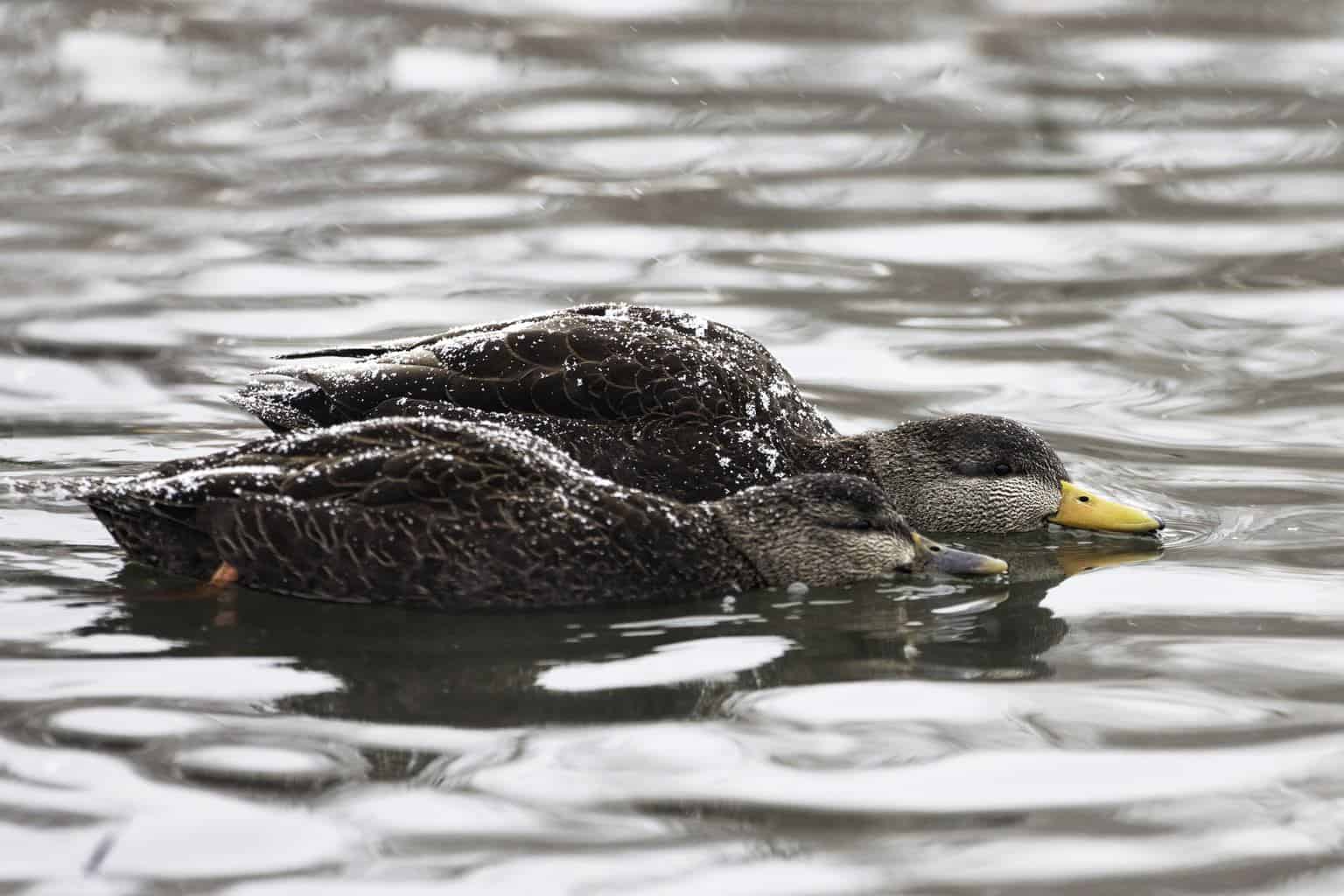
- Anas rubripes
- Length: 21.3-23.2 inches
- Weight: 25.4-57.9 ounces
- Wingspan: 34.6-37.4 inches
Both male and female American black ducks look similar to the female mallard in pattern and shape, but they’re a darker shade of brown with a different bill color.
Female mallards have gray and orange bills, but the female black duck has an olive green bill. Males have yellow bills.
In addition to looking similar to mallards, American black ducks are known to hybridize with mallards, creating an even more difficult identification.
The northernmost stretches of the Mountain State may see breeding American black ducks stay for the whole year, but they’re more likely to be migratory stopovers or winter visitors to West Virginia.
Gadwall
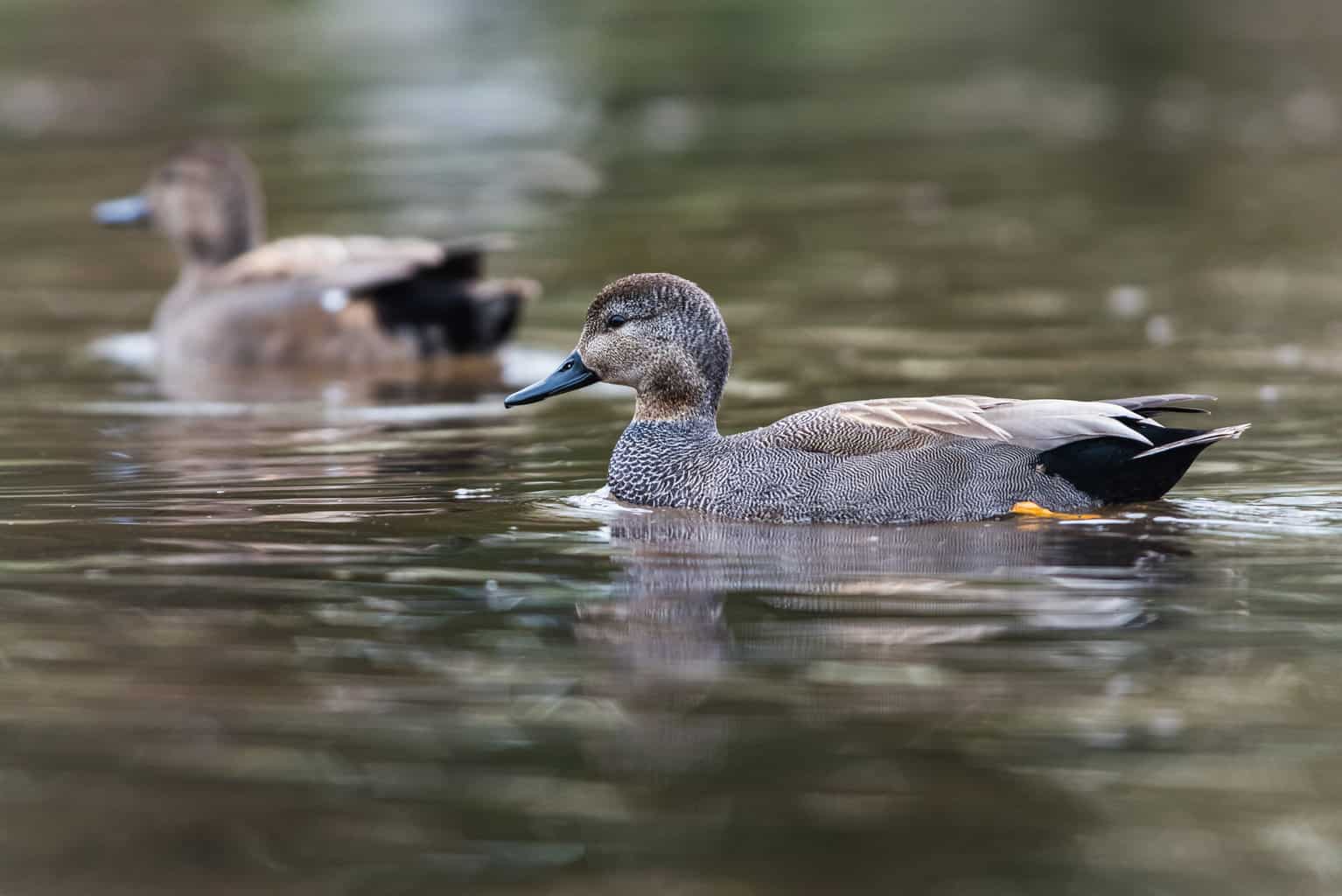
- Mareca strepera
- Length: 18.1-22.4 inches
- Weight: 17.6-44.1 ounces
- Wingspan: 33.1 inches
Gadwall are typically brief visitors in West Virginia during the spring and fall migration periods.
Despite lacking the exciting colors of some other male ducks, male gadwalls have an understated appeal in their intricate patterns of gray and brown.
They have black tail ends bordered by a white patch when not in flight and chests patterned in sequin-sized markings. They have black bills.
Once again, females are similar in pattern to the previous ducks on the list such as mallards, with orange bills that are slightly thinner than the mallard’s.
Blue-winged Teal
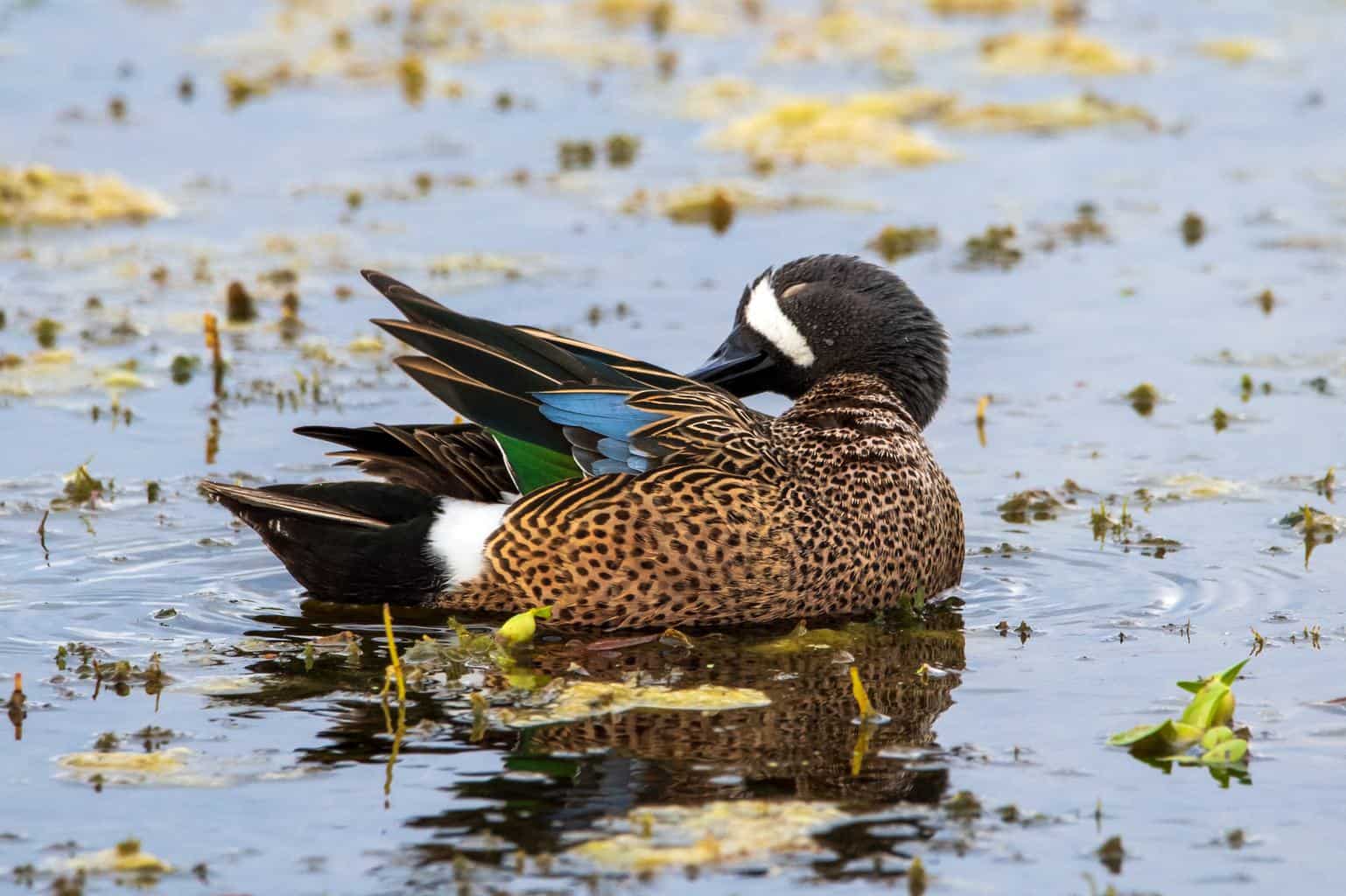
- Spatula discors
- Length: 14.2-16.1 inches
- Weight: 8.1-19.2 ounces
- Wingspan: 22.1-24.4 inches
Your best bet to see a blue-winged teal during the summer months in West Virginia is going to be along the Ohio River, where they may breed. The rest of the Mountain State is a brief visit for any teal passing through on their migration path.
Blue-winged teal don’t stick around and wait for it to start getting cold. They are some of the earliest migrants each fall, often starting their annual migration in late August or early September.
Blue-winged teal males are sharp birds, identified primarily by a thick white crescent marking between the eye and bill. In flight, wing patches of powder blue, green, and white expand from their speckled brown sides. Their heads may range from gray to slate blue.
Females are brown all over with slightly darker browns on the top of the head and along their eyeline. At between 14 and 16 inches, a female blue-winged teal’s size may also help you to identify her.
Green-winged Teal
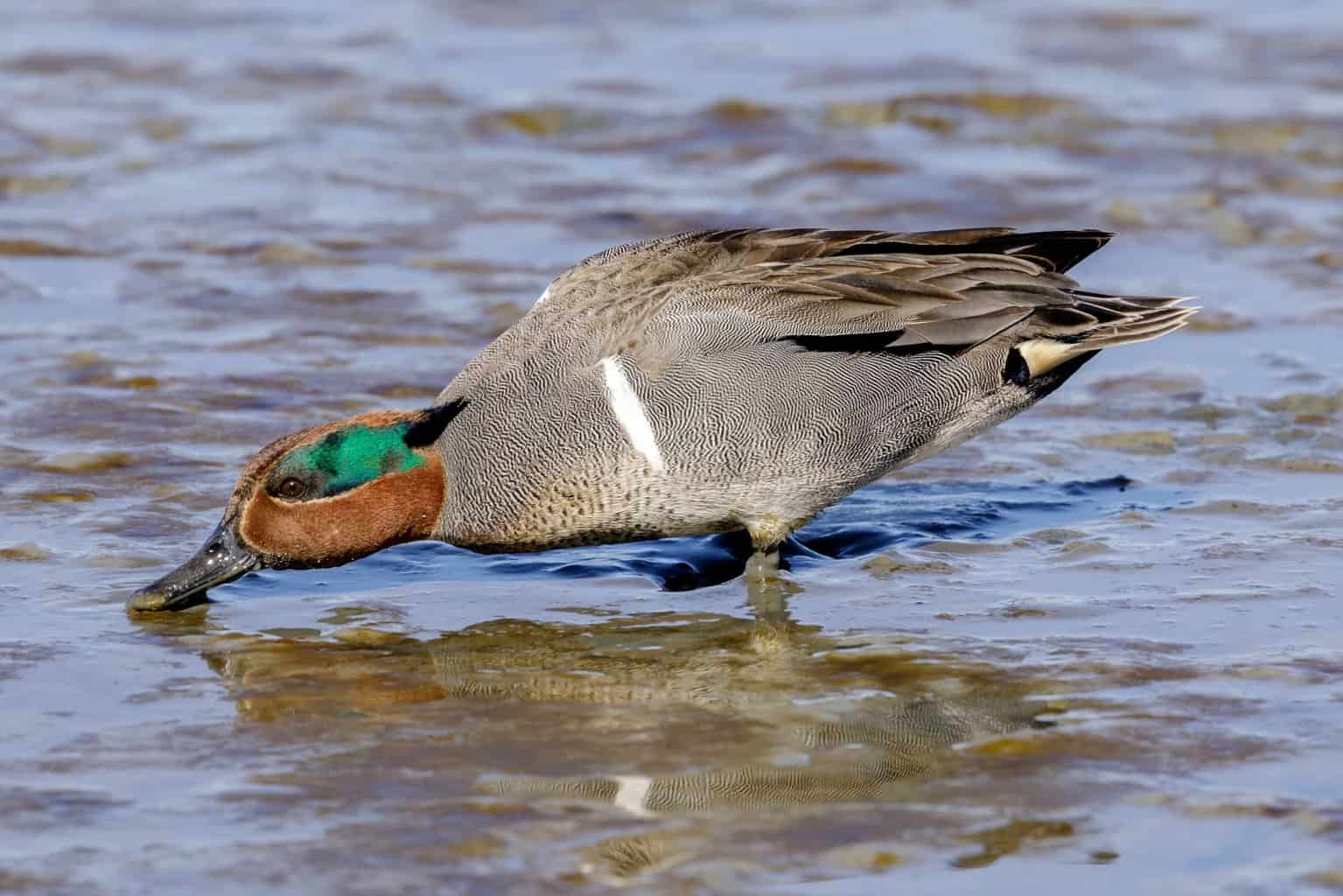
- Anas carolinensis
- Length: 12.2-15.3 inches
- Weight: 4.9-17.6 ounces
- Wingspan: 20.5-23.2 inches
Speaking of small, next on our list is North America’s smallest dabbling duck, the green-winged teal, measuring as little as a foot in length.
While it shares the name ‘teal’ with North America’s blue-winged and cinnamon teal, it shares a genus with the mallard, as well as several teal species from outside the continent. Their species name is sometimes listed as crecca, lumped in with the Eurasian, or common, teal.
Look for them in shallow water throughout wetlands and marshes as they migrate north and south each year.
Males are mostly gray until a horizontal meeting at the neckline with a chestnut-brown head. A green eye stripe adorns the side of the head from the eye toward the back of the neck. One vertical white stripe is present on each side.
Females are best identified by their small stature. One light stripe near the tail and a green shoulder patch visible in flight and occasionally on birds at rest may also help you to identify them.
American Wigeon

- Mareca americana
- Length: 16.5-23.2 inches
- Weight: 19.1-46.9 ounces
- Wingspan: 33.1 inches
Another dabbling duck with a green head stripe that angles from the front of the head to the back is the male American wigeon.
Males have light gray bills tipped in black and a white cap that extends to the bill. The rest of the body is a rusty brown until a white and black back end.
Females have tan bodies with grayish heads that come to a light gray bill just like the male.
Females’ signature marking is around the eye, where darker colors around a dark eye create a smudge-like appearance.
Look for American wigeons during migration periods in marshes and wetlands.
Northern Pintail
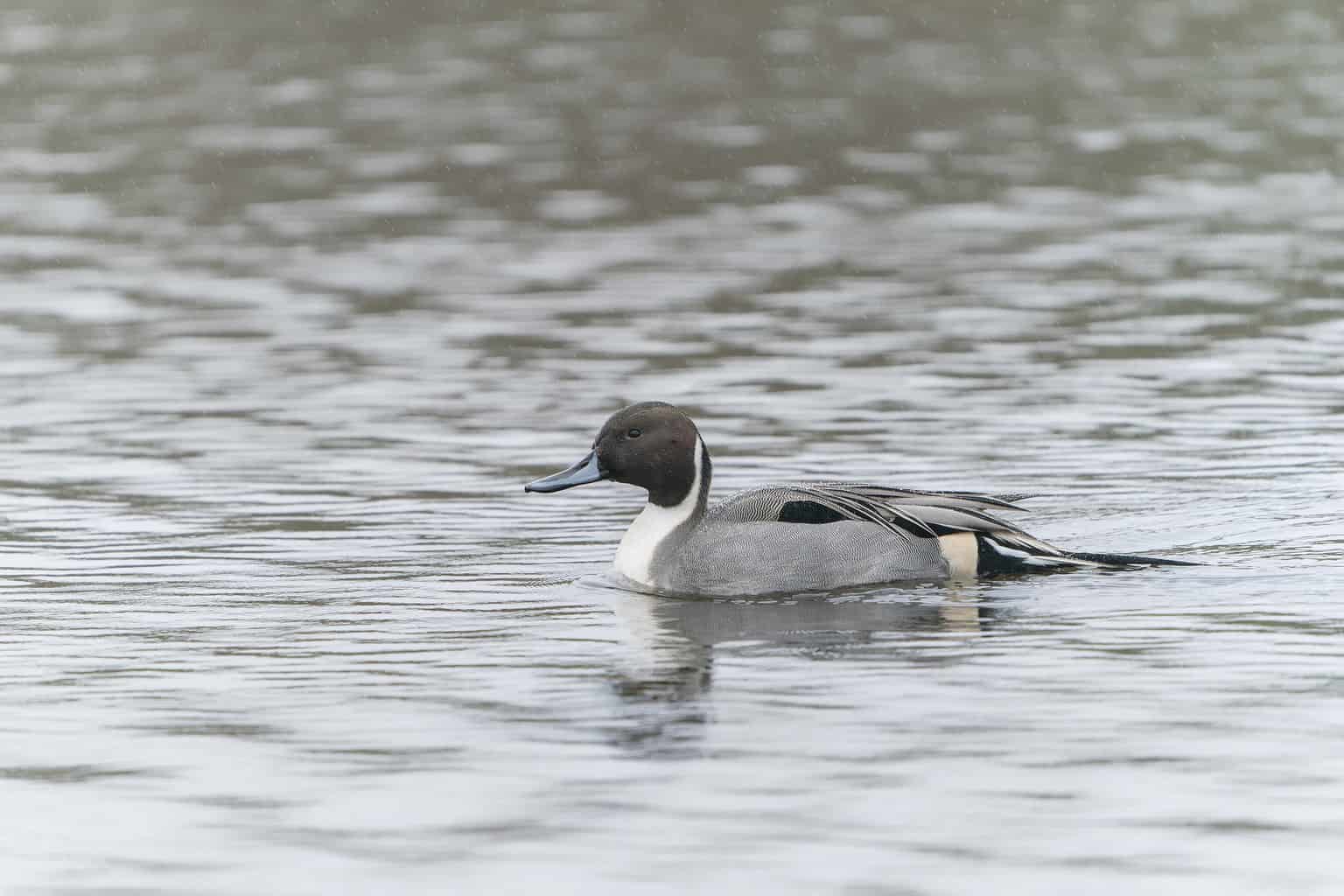
- Anas acuta
- Length: 20.1-29.9 inches
- Weight: 17.6-51.1 ounces
- Wingspan: 34 inches
From the category of male ducks with signature looks is the northern pintail, another migratory visitor to West Virginia.
Male pintails can most easily be identified by their long, thin tails that point out from behind in flight or angling up while at rest. This isn’t the only thing that can help you identify a pintail, however. Look for a long white neck that connects its chocolate brown head to a sleek, gray body.
Females’ tails are proportionately longer than many other duck species, so that might help you I.D. one, but they don’t stand out nearly as much as the male.
They have long necks and bodies patterned in brown.
Wood Duck

- Aix sponsa
- Length: 18.5-21.3 inches
- Weight: 16-30.4 ounces
- Wingspan: 26-28.7 inches
After so many migratory and winter visitors, we finally come to the wood duck, a year-round West Virginian.
Wood ducks are common throughout the North American Midwest and East throughout the year, where they nest near the water in wooded areas. It doesn’t always take much water for them, as a flooded forest or deep swamp may be enough to provide them with some temporary cover.
Males have beautiful patterns of rich browns and greens and crisp markings of black and white, unlike any other North American Duck, with red eyes and a crest at the back of the head. The only duck that rivals the wood duck in appearance is the Mandarin duck, the only other member of the Aix genus.
Ducks That Dive
Redhead
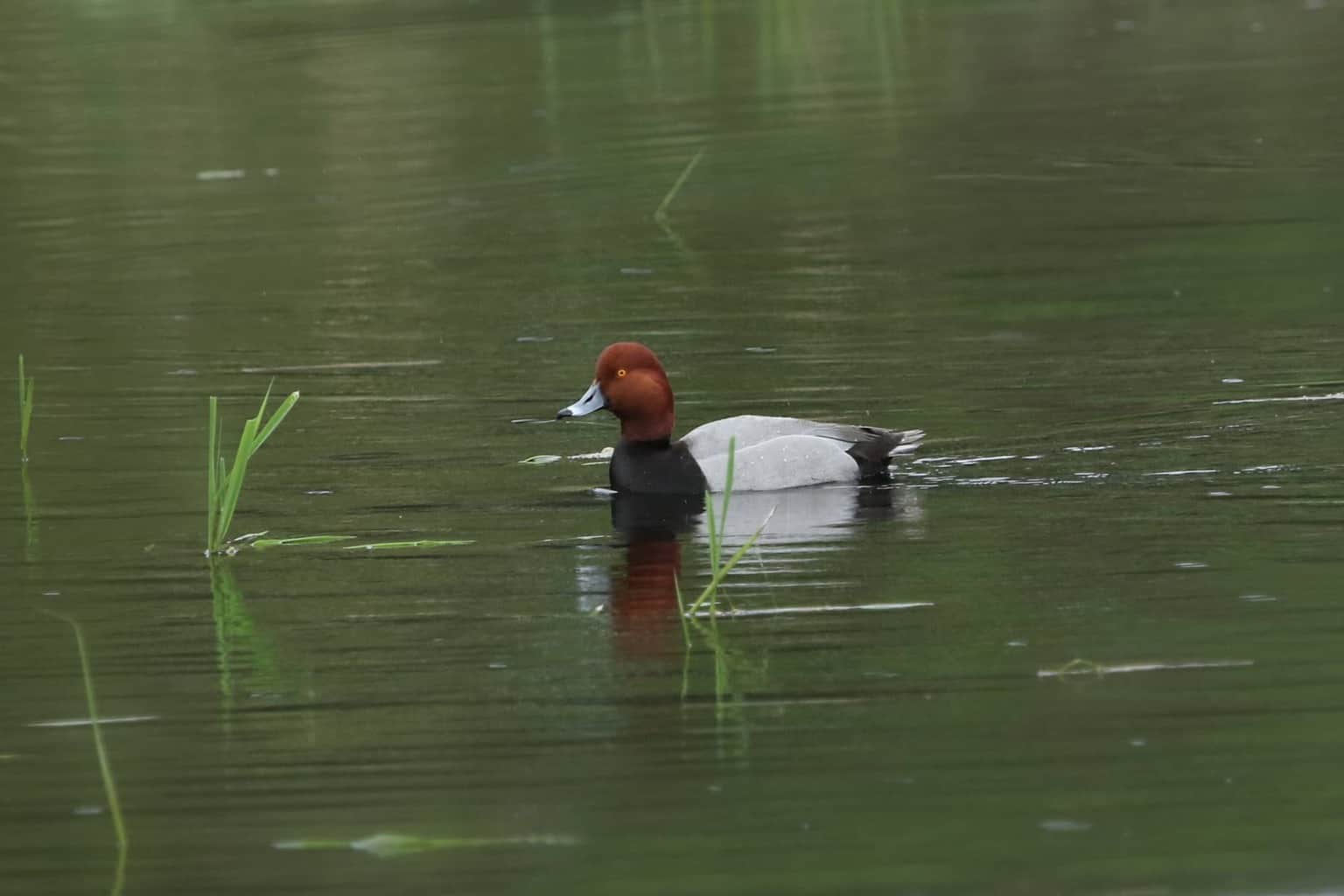
- Aythya americana
- Length: 16.5-21.3 inches
- Weight: 22.2-52.9 ounces
- Wingspan: 29.5-31.1 inches
Our first diving duck is the redhead, a resident of big open waterways in migration and winter. Most of the redheads to pass through West Virginia are likely on their way further south or east, but there may be some to stay the winter on big open waterways in the Mountain State.
Redheads are commonly seen in large groups, including in mixed groups of other ducks.
Male redheads have clearly defined gray sides, black chests, and chestnut brown heads. Their gray bills have black tips.
Female redheads have slightly darker bills, also with black tips. Their bodies are brown, lighter on the sides and darker above.
Canvasback
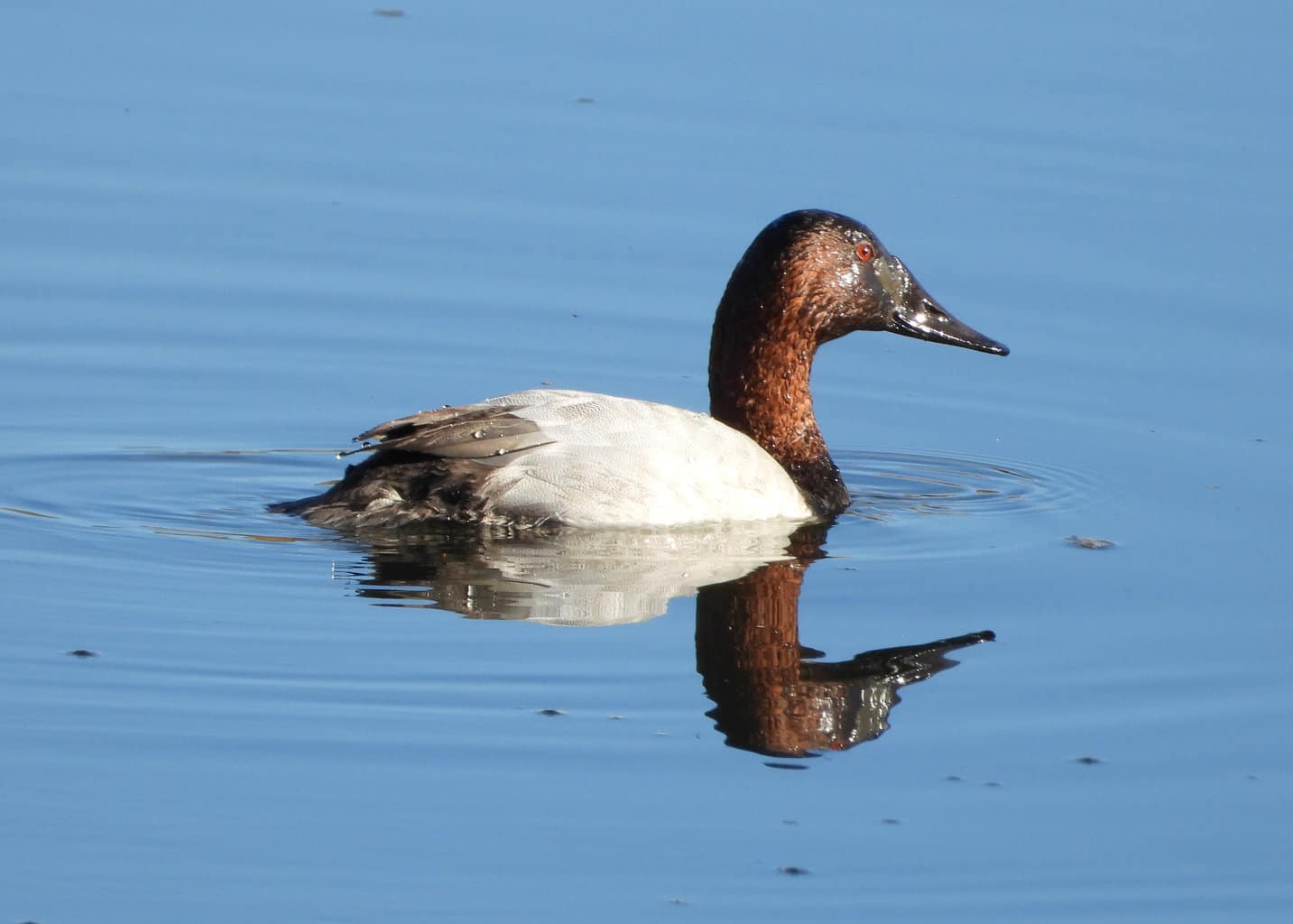
- Aythya valisineria
- Length: 18-9-22.1 inches
- Weight: 30.4-56 ounces
- Wingspan: 31.1-35 inches
Male canvasbacks also have clearly defined sections of color. White across their backs, sides, and bellies, canvasbacks have black chests and red-brown heads of a rather distinct shape.
The head of this diving duck slopes gradually into a black bill, which is different from the redhead’s more steeply graded forehead and round head. Canvasback males have bright red eyes.
Females are shaped the same, with a similar pattern to males but muted coloring. They have light gray, almost white bodies and brown necks, heads, and faces.
Canvasbacks can be found in similar places to redheads, and sometimes intermixed in groups with them and other species.
They breed in the North American West and spots along the Great Lakes region, traveling south and east in the fall. During this time and spring, canvasbacks could potentially be seen in West Virginia.
Greater Scaup
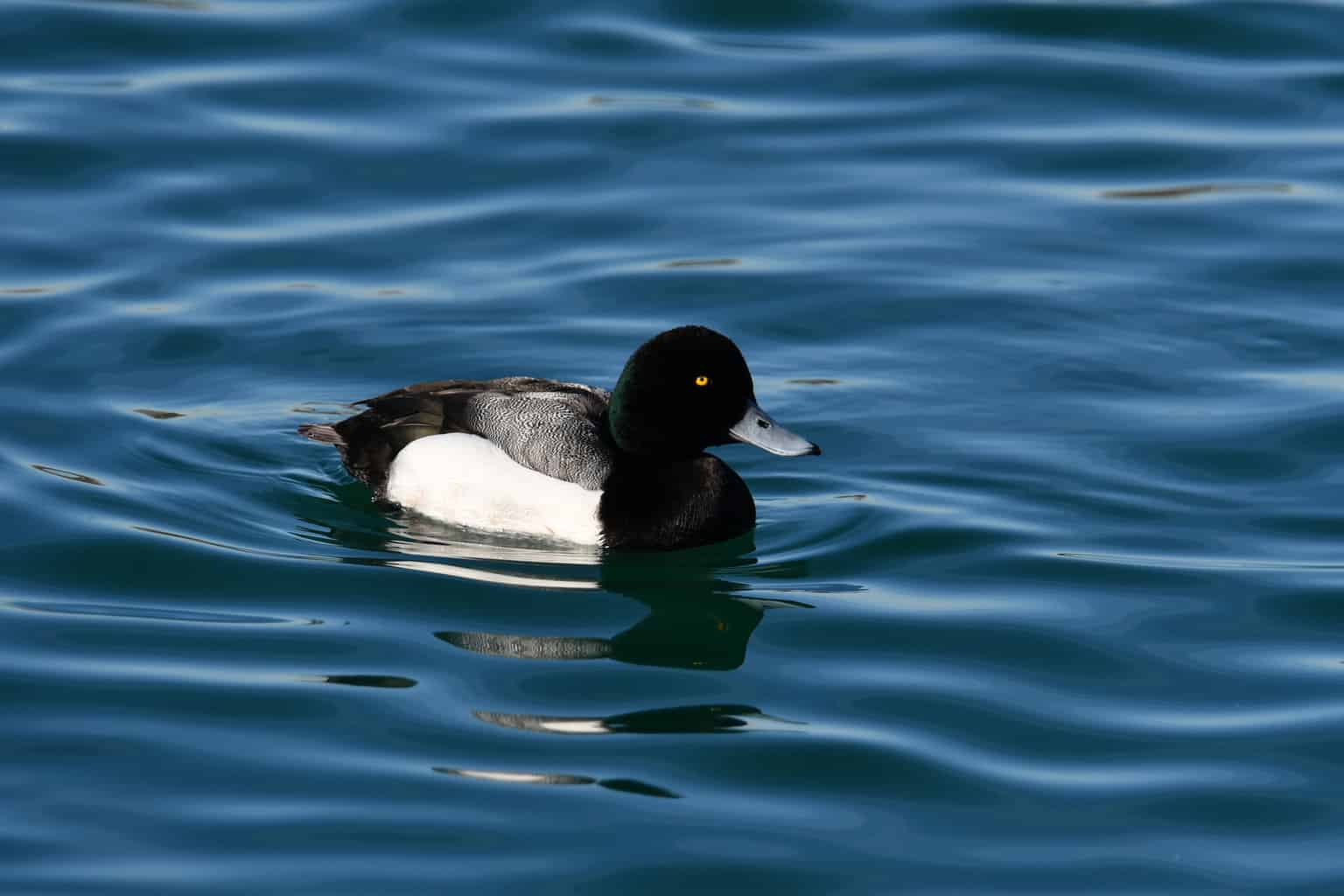
- Aythya marila
- Length: 15.3-22.1 inches
- Weight: 25.6-48 ounces
- Wingspan: 28.4-31.1 inches
The greater scaup is the larger of the two scaup species in North America. These medium-sized divers breed primarily in the northern stretches of Canada, with sporadic winter ranges across the United States and southern Canada.
Though they’re most common along the coasts, West Virginians are among those that may see greater scaup throughout the winter, such as along the Ohio River or other large lakes in the state.
Male scaup have well-defined sections of color: black chests and iridescent green-black heads with gray bills, white sides, and tops of patterned gray.
Females are mostly brown with a fluffy-looking white ring around the bill. Both males and females have yellow eyes.
Lesser Scaup
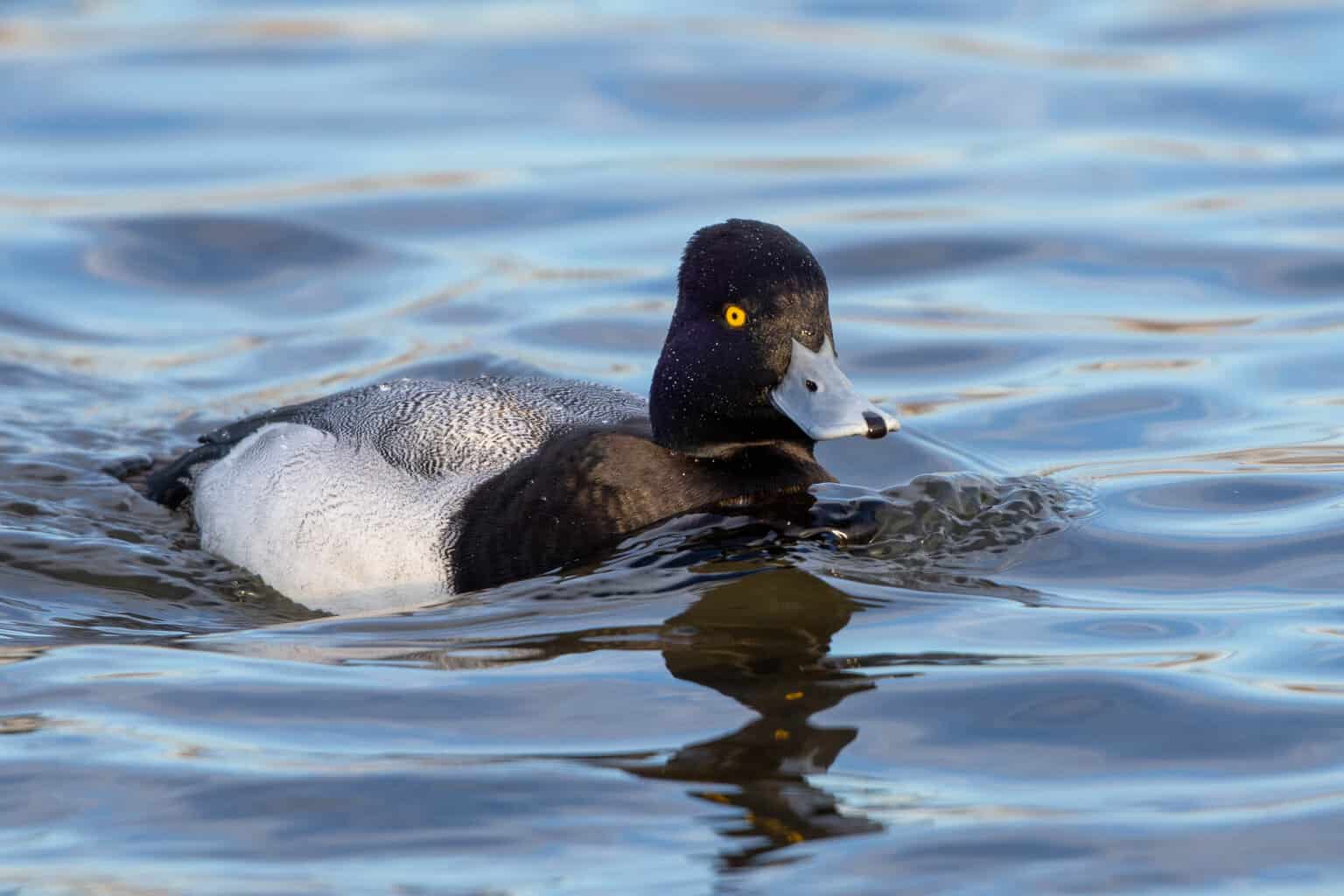
- Aythya affinis
- Length: 15.3-18.1 inches
- Weight: 16-38.4 ounces
- Wingspan: 26.8-30.7 inches
Very similar to the greater scaup is the lesser scaup, with similar patterns of gray, white, and black on the male and brown on the female.
In addition to the lesser scaup’s slightly smaller size, the easiest way to tell the species apart is by head shape. Greater scaup have more rounded heads compared to the lesser scaup’s peaked head, which appears smaller.
Though it’s perhaps fairly easy to see in a picture, it may be difficult for the untrained eye to tell the two apart, especially from long distances. A spotting scope or telephoto lens may help you determine between them.
Lesser scaup migrate from western North America to the coasts, which will lead some through West Virginia on a bi-annual basis.
Ring-necked Duck
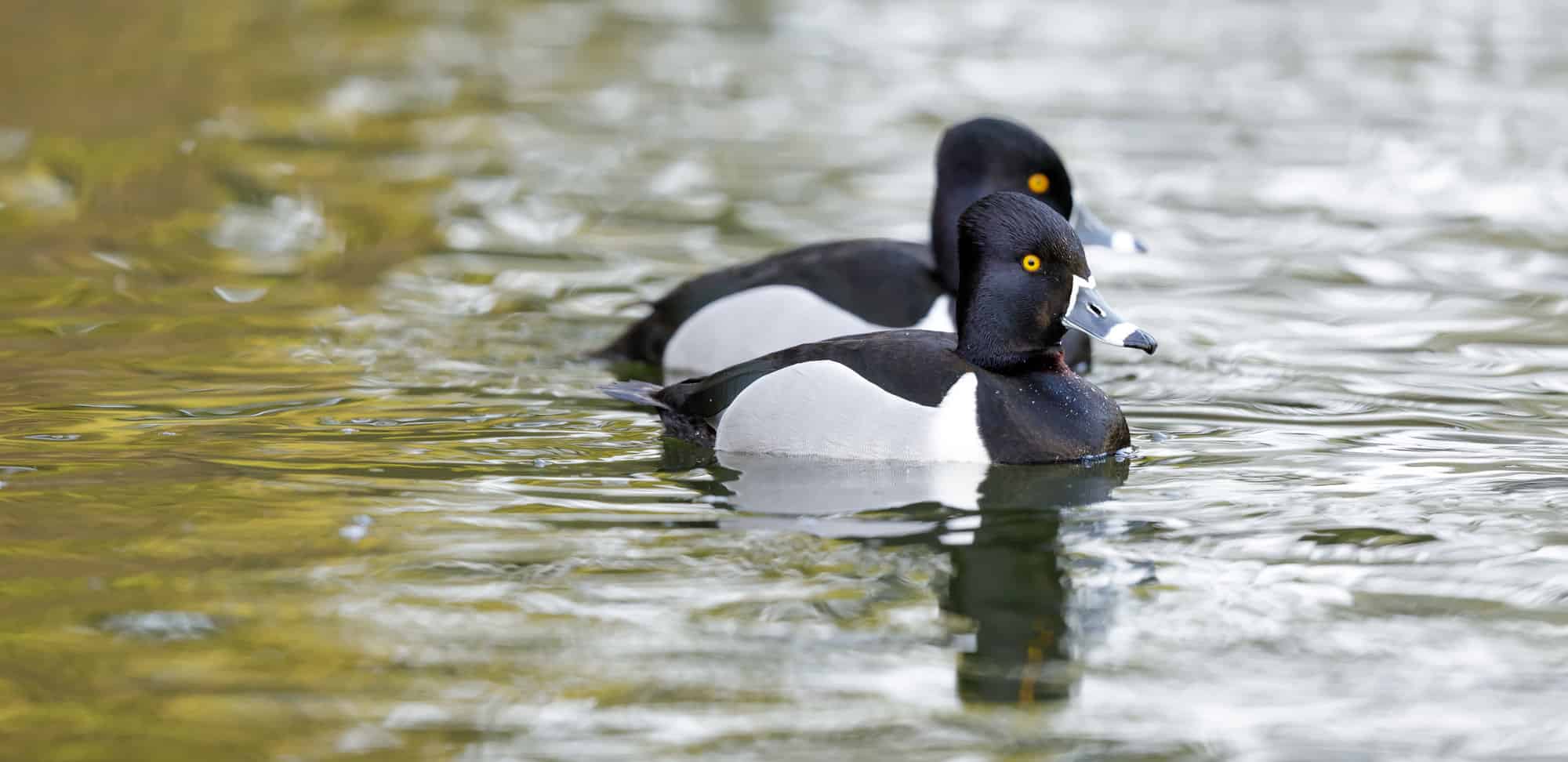
- Aythya collaris
- Length: 15.3-18.1 inches
- Weight: 17.3-32.1 ounces
- Wingspan: 24.4-24.8 inches
Closely related to scaup, the ring-necked duck has similar color patterns but a couple of key differences in appearance.
Males are mostly black, including on their backs, with a gray side when at rest. Their heads are sloped like scaup with a gray bill that features a black tip and two white rings– one around the base and one just in front of the tip.
Females are mostly brown, darker on top with lighter heads and faces. They also have one sharp white ring and a black tip on the bill. Unlike males’ yellow eyes, theirs are brown. Their white plumage surrounding the bill is not as pronounced as that of the scaup.
They are common as brief migratory visitors in lakes, rivers, and wetlands as they migrate between winter breeding grounds in the south and east and northern breeding grounds across the continent.
Common Goldeneye
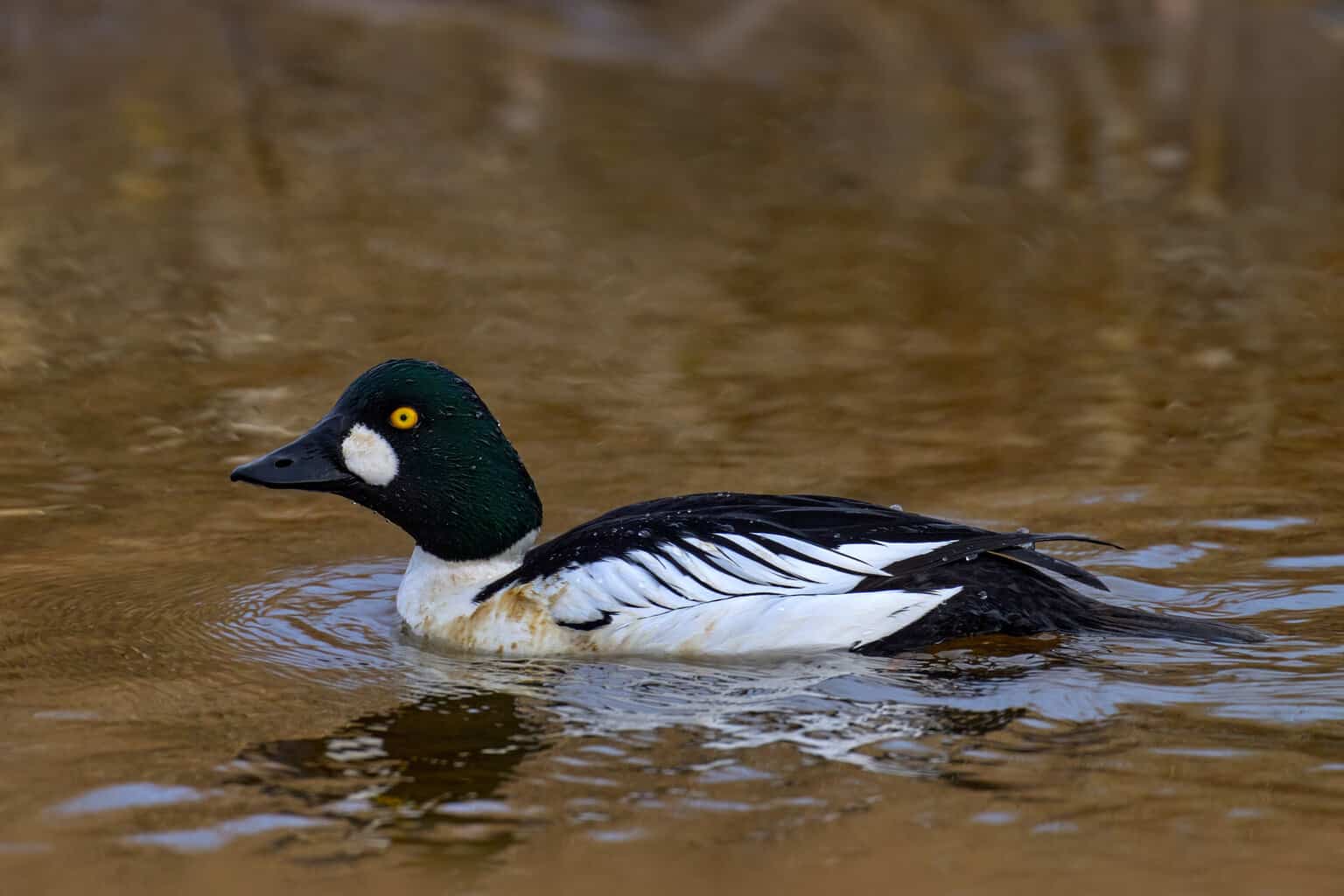
- Bucephala clangula
- Length: 15.8-20.1 inches
- Weight: 21.2-45.9 ounces
- Wingspan: 30.3-32.7 inches
The common goldeneye is one of America’s most familiar winter visitors. A breeder of colder climates in Canada and the northernmost United States, these birds fill lakes, rivers, and bays across the United States when winter rolls around.
Male common goldeneyes have white sides and bellies with black backs and black heads that may appear green in perfect lighting. A large white blob under the namesake yellow eye is a dead giveaway for this bird.
Females also have yellow eyes, which adorn a rich brown head. Their gray sides meet the head at a thin white neckline.
Bufflehead

- Bucephala albeola
- Length: 12.6-15.8 inches
- Weight: 9.6-22.4 ounces
- Wingspan: 21.6 inches
Another common winter diver across much of the United States, buffleheads seen in West Virginia are most likely to move on to warmer areas along the coasts after a little while.
One of the smallest birds on our list, buffleheads are also one of the most visually unique.
Males have iridescent heads that may appear blue, green, purple, or black, with a large white area on the back. Their bodies are black and white.
Females are best identified by a brown head with a horizontal white smudge just below and behind the eye.
Ruddy Duck

- Oxyura jamaicensis
- Length: 13.8-16.9 inches
- Weight: 10.6-30 ounces
- Wingspan: 22.1-24.4 inches
Ruddy ducks are breeders from the Great Plains and West, but the East and Gulf Coasts receive annual visitors each winter, meaning that flyover states like West Virginia get annual visits.
Ruddy duck males in breeding plumage have blue bills, striking brown bodies, and black and white heads, but their signature feature is a baby blue bill.
In non-breeding plumage, they aren’t nearly as unique. Their plumage fades to a dull brown and their bills turn black.
Females and males both have stocky tails that may sometimes stick straight up out of the water. Females are light brown with darker brown caps and a slightly darker stripe just below, running parallel to the cap.
They can be found anywhere from lakes to rivers as they pass through on the way to warmer waters outside of the summer months.
Common Merganser

- Mergus merganser
- Length: 21.3-27.9 inches
- Weight: 31.8-76.2 ounces
- Wingspan: 33.9 inches
Common mergansers are common sights on rivers in the north each year, where they breed and where some may spend the whole year.
Although common mergansers are sometimes spotted in the state during the summer, most West Virginian birders will have to wait until the fall, however, as common mergansers are primarily a wintering species in the state.
Look for them on lakes and rivers throughout the state. Their body shape may resemble that of a loon or a cormorant, except smaller than a loon and with a shorter neck than a cormorant.
They’re long, big-bodied birds with red bills. Males are black and white with striking green heads, while females are mostly gray and white with cinnamon red heads. Females have white patches along the chin.
Red-breasted Merganser

- Mergus serrator
- Length: 20.1-25.2 inches
- Weight: 28.2-47.6 ounces
- Wingspan: 26-29.1 inches
Another resident of the north, red-breasted mergansers move to the coasts during the winter months. Like many other birds on this list, you’re most likely to catch a glimpse of one on lakes and rivers during their annual migrations.
Males sport crested heads and long, straight, red bills. Connecting their heads to bodies adorned with gray, black, and white are a signature red breast and a thick white band around the neck.
Females look similar to female common mergansers, with mostly gray bodies and red-brown heads. They lack the white chin patch of the common merganser, which is probably the best way to tell the two apart.
Hooded Merganser
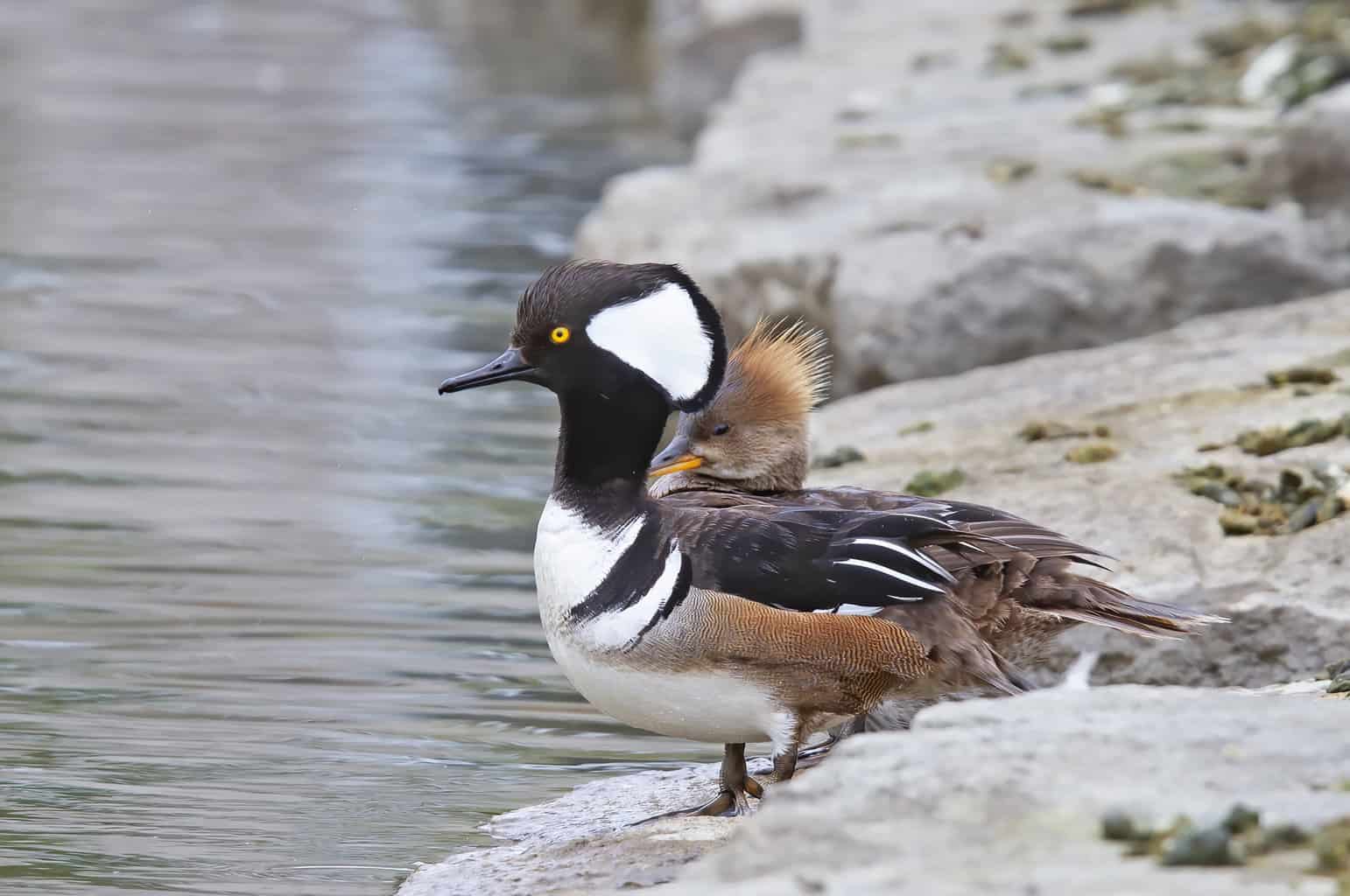
- Lophodytes cucullatus
- Length: 15.8-19.3 inches
- Weight: 16-31 ounces
- Wingspan: 23.6-26 inches
While West Virginia is flyover country for many of the ducks on this list, we end our list with the hooded merganser, a year-round resident.
Hooded mergansers make their summer homes in wooded areas near the water, as they nest in tree cavities, though they may move into less wooded areas during the winter when nesting cavities are no longer needed.
Males have brown sides, with the rest of their bodies featuring crisp blacks and bright whites. Their standout feature is a large black and white crest. When on full display, it makes the bird’s head look disproportionately large and circular, but it can also appear slumped back and hang over the top of the head.
Females have the same large crest, but it’s a reddish brown compared to the rest of the bird’s gray body.
More To Read and Explore
This is by no means a complete list of every possible duck that could be seen in West Virginia.
For example, in 2019 a Mandarin duck was repeatedly seen near Marmet Locks and Dam near Charleston and several Eurasian wigeons have been reported in the past decade. You never know what may show up in your state.
To keep exploring more interesting birds in the Mountain State, click here.

